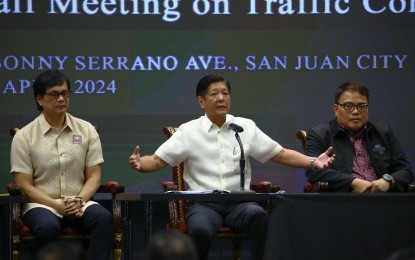
ADDRESSING TRAFFIC CONGESTION. President Ferdinand R. Marcos Jr. leads the Bagong Pilipinas Townhall Meeting on Traffic Concerns in San Juan City on Wednesday (April 10, 2024). The President gathered concerned government agencies, local government units, transport groups, and other stakeholders to come up with solutions to address the traffic congestion in Metro Manila. (PNA photo by Joan Bondoc)
MANILA – The government is fast-tracking the construction of mass transit projects to address Metro Manila's traffic congestion that hampers the country’s economic growth, President Ferdinand R. Marcos Jr. said Wednesday.
Speaking at the Bagong Pilipinas Townhall Meeting on Traffic Concerns in San Juan City, Marcos said the only solution to Metro Manila’s traffic congestion is to construct more mass transport systems.
“Nakikita natin sa mga ibang lugar, kahit ‘yung mga --- pag pupunta ka, sasakay ka ng tren, sasakay ka ng subway, makikita mo lahat ng klase ng tao doon sumasakay. Kahit ‘yung mga mayayaman na may kaya, sumasakay sa tren dahil ‘yun ang pinakamabilis. Iyong malalaking siyudad, New York ganoon, London ganoon (We see in other places, even those --- when you take the train, you take the subway, you see all kinds of people riding the train. Even the rich who have the means take the train because it's the fastest way of going around. Those big cities, New York is like that, London is like that),” Marcos said.
“Kaya talagang ito ay minamadali natin dahil nababanggit nga na napakalaki ang sagabal sa progreso natin itong traffic, hindi lamang sa oras na nasasayang, sa gasolina na nasasayang sa kakaantay na ura-urada sa daan, at yung gastos ng ating mga commuter (That's why we are really rushing this because it is mentioned that this traffic is a huge obstacle to our progress, not only in the time that is wasted, in the fuel that is wasted in the traffic jams on the road, and the travel cost for our commuters),” he added.
The President also enumerated the ongoing projects aimed at addressing the issue and provided updates about their construction.
The North-South Commuter Railway project, or the Tutuban to Malolos, is already 61 percent complete, while the North-South Commuter Railway Extension Project, or Malolos to Clark, is 56.5 percent complete, Marcos said.
The North-South Commuter Railway Extension Project-South extension, or Manila to Calamba, is 38 percent complete; Metro Manila Subway Project, 41 percent complete; LRT Line 1, Cavite extension, 80 percent complete; MRT Line 3 rehabilitation and maintenance, 85 percent complete; Unified Grand Central station, or the Quezon City common station, 83 percent finished; and the MRT line from Quezon City to Bulacan, 67 percent complete.
Decongesting Metro Manila
Another focus of the government in addressing the traffic woes in Metro Manila is to develop its nearby provinces, National Economic Development Authority (NEDA) Secretary Arsenio Balisacan said.
In the same public consultation, Balisacan said investors are being encouraged to do business in the provinces of Bulacan, Cavite, Laguna and Cavite to help decongest Metro Manila.
Likewise, the government, according to the NEDA chief, is supporting development projects in key regional hubs to improve the delivery of basic services.
“Kung ikaw ay nakatira sa probinsya, nararapat lamang na makatanggap ka ng dekalidad na serbisyo upang hindi mo na kailangang dumayo sa Manila para mag-aral, magpagamot, o kumuha ng dokumento mula sa mga tanggapan dito (If you live in the province, it is only right that you receive quality service so that you do not have to travel to Manila to study, receive treatment, or obtain documents from offices here)” he said.
LGUs’ role
Department of the Interior and Local Government (DILG) Secretary Benjamin Abalos Jr., meanwhile, underscored the vital role of local government units (LGUs) in addressing the traffic problem.
During the forum, Abalos said LGUs are taking the lead in road-clearing operations in both primary and secondary roads.
This came as he commended Barangay Holy Spirit in Quezon City for its road-clearing efforts, which resulted in the clearing of 92 roads and the dismantling of thousands of illegal structures.
The initiative led to the creation of an alternative route for motorists passing by the Commonwealth Avenue area, he added.
“Sa pangunguna ng ating mahal na Pangulong Marcos, patuloy po sana ang pakikiisa ng lahat ng mga kasamahang lokal na opisyal. Sa ating mga mayors at barangay captains, kausapin natin ang mga residente. Bumaba tayo. Ipaunawa natin na ang bawat mithiin at inisyatibo na ating gagawin at ng ating Pangulo ay upang magkaroon tayo ng mas ligtas na mga lansangan (Through the leadership of President Marcos, we call on our local officials to join this endeavor. To our mayors and barangay captains, let’s talk to our constituents. Let’s make them understand our goals and the initiatives undertaken by our President for us to have safer streets),” he added.
According to the Metro Manila Development Authority (MMDA), traffic volume in Metro Manila increased by 17.68 percent from 2019 to 2023 due to an increase in the volume of vehicles, accidents and drivers' undisciplined behavior. (with Lloyd Caliwan/PNA)
